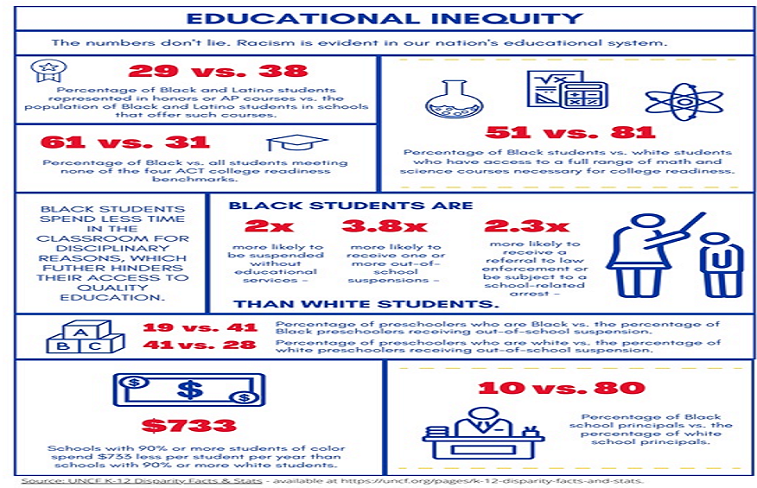 Disparity is not a new concept and we can see it almost everywhere, even in a school classroom as well. In the below image, we can see an example of racism and its statistics.
Disparity is not a new concept and we can see it almost everywhere, even in a school classroom as well. In the below image, we can see an example of racism and its statistics.

Source: pepcleve.org
Racism or disparity is one of the common situations which we can witness almost everywhere in the education sector and it’s the teacher’s responsibility to take active steps on the issue of race in the classroom. However, those teachers who have pursued courses like teacher training courses in Malaysia have the idea of how to eradicate this structural racism from the classroom and know how important it is to restore the balance as well.
Moreover, this blog post will also help teachers to know some effective strategies to eradicate the plague of racism from the roots to make an inclusive environment for every child, regardless of race, gender, or religion.
So, without any further delay, let’s get started.
8 Effective Strategies to Create Anti-Racism Classroom
1. Acknowledge the Impact of Race
To create an anti-racist classroom, it is essential to acknowledge the existence and importance of race. Pretending that race doesn’t matter or avoiding discussions about it only perpetuates the inequalities that students of color face. Instead, find safe spaces to explore your own biases and connect with other educators committed to levelling the playing field for all students. When issues or ideas about race arise in the classroom, use positive language to acknowledge and celebrate diversity while highlighting the commonalities among students.
2. Engage with Community Organizations
If you are teaching in the majority of color you may feel that there’s nobody out there to support those local families who are suffering from different racial challenges. However, that’s not the case; there are many organizations like cultural, religious, educational, and youth development groups who are looking for a chance to collaborate with schools to help those communities.
Collaborating with those communities will ultimately give a sense of confidence to your students after knowing their communities well and they will celebrate all the good things that only their culture can offer.
3. Embrace the Diverse Culture
A teacher is one of the important entities in the school, which plays a major role in creating an inclusive environment for every student. A teacher must know that there are various diversities within black, Latino, and Asian communities. Rather than following the stereotypical narrow perspective towards race that has been created by mass media.
As a teacher, you must make time to know every student’s background and race, you can invite their parents to broaden your racial knowledge, which will help you to know different norms, and traditions which will ultimately help you to create a sense of community which values every race cultural value and appreciate student from different backgrounds.
4. Educate Yourself
To effectively teach students who may not share your background, it is essential to educate yourself about their experiences and learning needs. Authors like Lisa Delpit and Kathleen Cushman have produced valuable resources for teaching students from diverse backgrounds. Seek out books, articles, and professional development opportunities that can enhance your understanding of race and its impact on education. By developing a new level of consciousness, you can positively influence the success of all your students.
5. Practice Self-Awareness
Creating an anti-racist classroom starts with self-reflection and self-awareness. Ask yourself challenging questions to uncover any biases or unfair treatment within your classroom. Reflect on the students you tend to punish or label, the frequency and nature of communication with their parents, and the feedback and reinforcement you provide.
You can ask questions like- Do you hold high expectations for all students? How do you express those expectations? And if you hold high expectations then how do you express those expectations?
Becoming aware of yourself is a very crucial step to creating an inclusive environment for your students.
6. Address Bias in Classroom Management
A teacher often gets biased in the classroom whether it’s consciously or subconsciously which could lead to unfair treatment of students of different races and many factors. As a teacher, you must observe your actions within the classroom to see whether your action is based on biases of race or disparity or not.
Implement restorative justice practices that focus on repairing harm and fostering positive relationships, rather than punitive measures. This will create a positive and inclusive environment for the students.
7. Become a Culturally Aware Teacher
As a teacher, you must be a culturally responsible teacher and recognize the value and different cultural backgrounds of every student. If you’re being able to incorporate their cultural references and experiences in the learning process then you will be able to create a more meaningful and engaging learning experience for your students.
This will ultimately help students to feel, heard and valued which will boost student’s self-esteem and motivation to perform even better academically.
8. Continuously Reflect and Adapt
Creating an anti-racist classroom is an ongoing process that requires continuous reflection and adaptation. Regularly assess your practices and their impact on students. Seek feedback from students, parents, and colleagues to gain different perspectives and identify areas for improvement. Stay informed about current research, trends, and best practices in anti-racist education. By remaining open to growth and willing to adapt, you can make a lasting impact on the educational experiences of all your students.
No Place For Disparity or Racism in Education System
Every child is special and equal and deserves to be treated equally. However, in reality, we often witness racism or disparity in most of the classrooms in every corner of the world. Now, it’s high time for every teacher to take active steps to eradicate racism from the whole education system, those teachers who have pursued courses like a teacher training course in Malaysia , know it already and also know how to remove it.
However, this blog post also contains several effective steps with which teachers can desiccate the racism system within the classroom, by creating an inclusive environment so that every child feels included.





